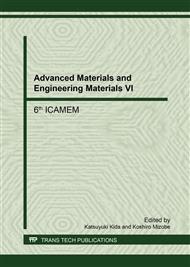[1]
J P Chen, C Y Kuo, W L Lee, Thermo-responsive wound dressings by grafting chitosan and poly(N-isopropylacrylamide) to plasma-induced graft polymerization modified non-woven fabrics, Applied Surface Science 262 (2012) 95.
DOI: 10.1016/j.apsusc.2012.02.106
Google Scholar
[2]
A. Ceria, G. Rovero, S. Sicardi, F. Ferrero, Atmospheric continous cold plasma treatment: Thermal and hydrodynamical diagnostics of a plasma jet pilot unit, Chemical Engineering and Processing 49 (2010) 65.
DOI: 10.1016/j.cep.2009.11.008
Google Scholar
[3]
Y. Zhang, M. Zhang, B. Gu, Surface modification of non-woven polypropylene fabric by atmospheric nitrogen dielectric barrier discharge plasma, Chinese Journal of Vacuum Science and Technology 30(4) (2010) 438.
DOI: 10.1016/j.apsusc.2010.04.101
Google Scholar
[4]
H. S. Choi, T. G. Shikova, V. A. Titov, V. V. Rybkin, Surface oxidation of polyethylene using an atmospheric pressure glow discharge with liquid electrolyte cathode, Journal of Colloid and Interface Science 300 (2006), 640.
DOI: 10.1016/j.jcis.2006.04.001
Google Scholar
[5]
S. Kanazawa, M. Kogoma, S. E. A. Okazaki, Glow plasma treatment at atmospheric pressure for surface modification and film deposition, Nuclear Inst. Methods in Phys. Res. B37 (1989) 842.
DOI: 10.1016/0168-583x(89)90310-8
Google Scholar
[6]
P. P. Tsai, L. C. Wadsworth, J. R. Roth, Surface modification of fiabrics using a one-atmosphere glow discharge plasma to improve fabric wettability, Text Res. J. 67 (1997) 359.
DOI: 10.1177/004051759706700509
Google Scholar
[7]
M. Šíra , S Bashir, Hydrophobic-Hydrophilic Character of Hexamethyldisiloxane Films Polymerized by Atmospheric Pressure Plasma Jet, Plasma Chem. Plasma Process. 35 (2015) 739.
DOI: 10.1007/s11090-015-9623-z
Google Scholar
[8]
Y. Zhang, Y. D. Lv, Surface modification of polypropylene melt blown non-woven using atmospheric pressure dielectric barrier discharge plasma, Applied Mechanics and Materials 42 (2011) 228-231.
DOI: 10.4028/www.scientific.net/amm.42.228
Google Scholar
[9]
L G Piper, State-to-state energy-pooling reactions I. formation of and the Herman infrared system, The Journal of Chemical Physics 88(1) (1988) 231.
Google Scholar
[10]
J S Morrill, W M Benesch, Role of in the enhancement of populations in the afterglow, The Journal of Chemical Physics 101(8) (1994) 6529.
Google Scholar
[11]
M F Golde, Reactions of , Int. J. Chem. Kinet. 20(1) (1988) 75.
Google Scholar
[12]
L G Piper, The excitation of in the reaction between and , The Journal of Chemical Physics 77(5) (1982) 2373.
Google Scholar
[13]
D Z Cao, D W Setser, Energy-transfer reaction of nitrogen to sulfur monoxide and other diatomic and polyatomic molecules, Journal of Physical Chemistry 92(5) (1988) 1169.
DOI: 10.1021/j100316a034
Google Scholar


